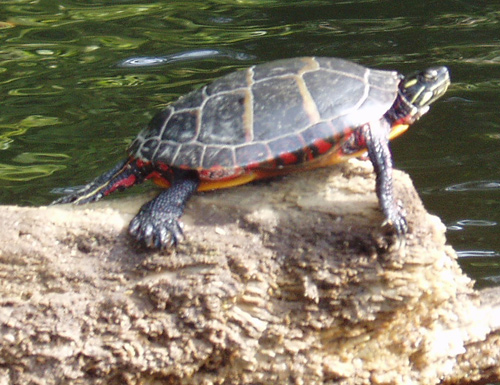The eastern painted turtle is a small to medium turtle. Its shell, or carapace, is rather flat and is dark with orange markings along the lower edge. It's oblong in shape and smooth. The lower shell, or plastron, is orange The turtle's body is dark with yellow neck stripes and red stripes on the front legs. The carapace of painted turtles can be 4 to 10 inches long.
Eastern painted turtles range from southeastern Canada through New England. They are found in Atlantic coast states south to nothern Georgia and eastern Alabama. Other subspecies inhabit areas in the northern and western US- painted turtles are the most widespread turtles in North America. In Connecticut eastern painted turtles are found throughout the state in low-lying areas. They are the most familiar turtle here.
These turtles are highly aquatic. They prefer shallow, slow-moving streams and rivers with muddy bottoms and weedy shallow ponds.
Eastern painted turtles nest in May or June. A female digs a flask-shaped nesting cavity, about 4 inches deep, in sandy soil in a warm, sunny spot. She lays 2 to 20 elliptical eggs. After laying she may push leaves and grass over the spot to camouflage it. One of the rare times a painted turtle leaves the water is to locate a nesting site. Females are vulnerable to being run over if they cross roads to find a good spot. They can produce 2 to 4 clutches annually in warmer climates, but produce 1 to 2 farther north. Incubation takes 10 to 11 weeks. Most of the hatchlings overwinter in the nest and come out in spring, usually at night. When they emerge they head for water. It is believed that the increased reflection of light from water surfaces into the night sky is what guides newly emerged turtles to water. Female turtles reach sexual maturity at 4 to 8 years, males at 2 to 4 years. An eastern painted turtle's lifespan is over 30 years.
The gender of baby painted turtles is determined by the temperature of the eggs during a particular stage of development. This is common for many turtle species. Low temperatures and high temperatures seem to produce all females while moderate temperatures produce all males. The temperature within a natural nest can vary, so a clutch can produce mixed gender babies.
These turtles hibernate for the winter buried in mud on the bottom of lakes, ponds or streams. These turtles are active for more of the year than many freshwater turtles, but in New England will spend at least 4 months in hibernation. Painted turtles are active during the day and sleep on the river bottom at night. They spend many hours of the day basking in the sun on partially submerged rocks or logs. Turtles cannot regulate their body temperature internally and must warm themselves in the sun. The turtles often bask in the morning, spend some time hunting food, then return to bask again in the afternoon. You often see several turtles piled atop one another on a favorite basking spot.
Painted turtles are omnivorous but young turtles tend to be more carnivorous while older turtles eat more plant matter.
Unlike most turtles, painted turtles shed the scales, or scutes, on their shells. One can sometimes see one with scutes that appear to be in the process of flaking off.
